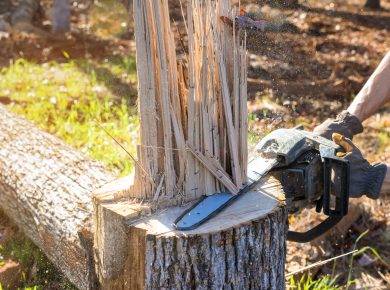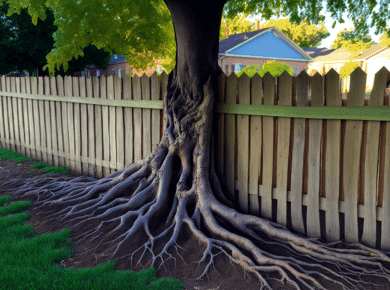Table of Contents
- A neighbor cut down my tree in Missouri
- My neighbor cut my tree in Missouri
- My tree branches overhang my property in Missouri
- My neighbor damaged my tree on my property in Missouri
- My neighbor’s tree roots or branches damaged my property in Missouri
- Can my neighbor make me cut my tree?
- How can I get my neighbor to cut his dead tree in Missouri?
- What happens if I cut my neighbor’s tree down in Missouri?
- If your property was damaged click here to see if you might have a case.
A neighbor cut down my tree in Missouri
If your neighbor has cut down your tree in Missouri, you have legal options available to you to right this wrong. It is against the law to remove a tree without permission of the rightful owner, so if it has happened to you, you may choose to pursue a legal course of action.
The first step for a neighbor cutting down your tree in Missouri is to contact your local city hall and inquire about any ordinances that the neighbor may have violated. Depending on the city, there may be different ordinances that pertain to the felling of trees and your neighbor may be in violation of one of them.
You should then look into how the tree felling affects you personally. Does the tree in question provide you with a natural barrier between your property and theirs? Was it for decorative purposes? Does it affect any utility lines or feed water to crucial areas on your property? These are all valid points to make when discussing the tree felling with your neighbor and possibly the court.
After assessing the damage done to you, it may be time to pursue legal action. If your neighbor refuses to take responsibility for the felling of your tree, then it may be time to contact a lawyer who practices in this type of case. The lawyer you choose should be able to represent you in court and help you get the compensation you deserve. With the right lawyer on your side, you can rest assured that your neighbor will be brought to justice for cutting down your tree in Missouri.
The most important thing to remember is that you have legal options available for neighbors cutting down your trees in Missouri.
Contact your local city hall and take the time to assess the damage done to you, then contact a lawyer who practices in these cases to ensure your property rights are placed at the highest regard.
With the right lawyer on your case, you can rest assured that your neighbor is held responsible for their wrongdoings.
My neighbor cut my tree in Missouri
If your neighbor cut your tree in Missouri, you should first talk to them about the potential violation of the town’s code and explain why you’re concerned about the consequences. If a conflict arises between the two of you, Missouri has a few legal methods you can use to address the situation.
If your tree was cut without permission or a tree-related zoning permit, or if the trimmer failed to properly clean up the debris, you can contact the local government’s tree management office to file a complaint. This will help document the incident and trigger an investigation into any code violations that may have occurred. If the code violation is verified, you may be able to pursue rectification efforts with your neighbor.
In Missouri, local towns and cities have laws that protect trees from being cut down without approval. If you believe the tree has been illegally cut down, you can hire an attorney to help you file a civil lawsuit against the neighbor.
You can also try to work out a neighborly agreement. If both sides come to an amicable resolution, the mutual agreement can serve as a settlement agreement, or court-policed contract, to resolve any disputes regarding the tree trimming.
Finally, it helps to collaborate with other neighbors who may have witnessed the tree-cutting incident. The combined testimonies may improve your chances in a lawsuit.
These steps will help you take legal action against your neighbor in Missouri and help ensure that your rights as a property owner are respected.
My tree branches overhang my property in Missouri
If your tree branches in Missouri are overhanging onto your property, you may be able to trim them to a reasonable extent without permission from your neighbor.
Step-by-Step Guide:
1. Check your local regulations: Depending on where you live, there may be local municipal ordinances related to trimming your trees. Find out if any such ordinances exist, so you’ll know the extent to which you can trim the branches.
2. Discuss the issue with your neighbor: If you want to avoid any legal issues, it’s best to talk to your neighbor to discuss the issue before taking any action. They may be amenable to removing the branches themselves, or may agree to let you do so as a compromise.
3. Choose the appropriate pruning tool: You’ll want to use an appropriate pruning tool, such as a hand saw, pruning shears, or pole saw. Be sure to wear safety equipment and use caution when working with the tools.
4. Make small, controlled cuts: Make small, controlled cuts when trimming the branches, as this will help the tree heal faster and reduce the risk of further damage. Avoid cutting off the entire branch; instead, make small cuts along the branch to gradually reduce its length.
5. Dispose of the pruned branches: It’s best to dispose of the pruned branches separately from your regular yard waste. Consider chipping them or composting them so they don’t end up in a landfill.
By following these steps, you can safely trim the branches of your tree in Missouri without running into legal trouble. Be sure to do so safely and responsibly to prevent any further damage.
My neighbor damaged my tree on my property in Missouri
If your neighbor damaged your tree on your property in Missouri, you have the right to seek compensation and legal recourse. This guide will provide you with an overview of the steps to take if you find yourself in this unexpected situation.
First, take photos of the damaged tree and any destruction it may have caused. Be sure to collect the names and contact information of any witnesses who can verify that the tree was indeed damaged by your neighbor.
Second, review Missouri state laws regarding trespassers. In most cases, it is illegal to damage trees on another person’s property without permission, so your neighbor may be liable for any destruction caused.
Third, contact an experienced property damage attorney and discuss the circumstances of the damaged tree. Your attorney can advise on the best way to proceed with filing a claim.
Fourth, communicate with your neighbor and explain the situation. Request that they fix the damage caused and/or provide compensation. If they don’t, your attorney can help determine the best course of legal action.
Finally, you may decide to report the incident to your insurance company. Most homeowners’ policies cover property damage from trees, so it may be in your best interest to file a claim.
Ultimately, no matter the circumstances, make sure that you document the damage and keep records of communication with your neighbor and any legal representatives. This will help ensure that you get the compensation you are rightfully due for the damaged tree.
My neighbor’s tree roots or branches damaged my property in Missouri
If a neighbor’s tree roots or branches have damaged your property in Missouri, you may have a legal claim against your neighbor.
This guide will outline some of the steps to consider when dealing with this type of situation.
1. Take pictures of the damage, and document the destruction with written notes. Include dates and descriptions of the damages, as well as any costs you have incurred in dealing with them.
2. Notify your neighbor in writing of the damages and demand that he or she take action to remedy the problem.
3. If your neighbor does not take responsibility for the damages, you can file a civil suit.
4. Contact a lawyer who practices in property law for advice about the extent of your neighbor’s liability, and whether you can claim damages from them.
5. In a civil suit, the burden of proof rests on you to demonstrate that your neighbor’s tree caused the damage. The evidence you have collected about the damage and the written notification you sent to your neighbor will be useful in this regard.
6. Depending on the extent of the damage and whether it can be rectified easily or will require costly repairs, you should consider the potential implications on your relationship with your neighbor.
7. If you choose to sue your neighbor, you would typically file a complaint in the civil division of the circuit court that covers your locality in Missouri.
Hopefully this guide is useful in helping you deal with a situation in which your neighbor’s tree roots or branches have damaged your property in Missouri. Good luck!
Can my neighbor make me cut my tree?
Can my neighbor make me cut my tree? This is a question that has been asked many times, and the answer depends on a few factors.
First, it’s important to understand what your rights are as a property owner, in terms of planting trees. In general, all property owners have the right to maintain landscaping on their land, including the planting and removal of trees.
In some areas, however, there may be city or county restrictions on the planting of specific types of trees or the size and placement of trees. It is important to check local regulations before beginning any tree-related project.
In some cases, a tree may be overhanging a neighbor’s yard, and if that neighbor feels its roots are encroaching upon their property, they may be able to bring a local court order to require you to cut it back.
If your neighbor alleges harm they’ve suffered from the tree, they may need to demonstrate that the tree has done actual damage—for example, by causing the roots to break up sidewalks, or producing sap that stains siding—in order to be successful in a lawsuit.
Finally, if a tree is blocking light to a neighbor’s bedroom window, or producing an excessive amount of noise, a neighbor might legitimately be able to gain a court order to make you remove it.
In all cases, it is important to understand your local regulations, and to make sure your trees are planted and maintained responsibly. If you do find yourself in a dispute with a neighbor over a tree, it may be best to consult a qualified attorney or attempt mediation before escalating the issue to a court.
How can I get my neighbor to cut his dead tree in Missouri?
If your neighbor’s trees are dead or dying, it is important to take the proper steps to get your neighbor to cut the tree down.
1. Assess the damage – It is important to assess the danger that the dead tree poses. If it is located near your home or another structure, the dead tree can become hazardous if it falls. If the tree is a large species, its crown may extend over the property line, which can cause an issue with your neighbor. You can request an assessment from a certified arborist or horticulturist to determine the damage.
2. Contact your neighbor – Once you have assessed the damage, you should contact your neighbor and discuss your concerns. Let them know that the tree is dead or dying, and the potential danger it presents. Explain your reasons for wanting the tree to be removed, and how this can benefit both of you.
3. Negotiate with your neighbor – If your neighbor is not willing to remove the tree, you may need to negotiate. Offer to pay for a portion of the cost of cutting it down. You can also suggest that they get a professional to do the job, to help ensure it is done safely.
4. Have a legally binding agreement – To avoid any potential disputes, it is important to have a legally binding agreement. Your neighbor will need to agree to cut the tree down in a reasonable amount of time. They should also agree to cover the costs of removal and clean up.
Following these steps can help you get your neighbor to agree to remove the dead or dying tree from their property. It is also important to note that in many areas, such as Missouri, homeowners are responsible for keeping any dead or dying trees on their property from becoming a hazard. By taking steps to get your neighbor to cut it down, you can protect both you and your neighbor.
What happens if I cut my neighbor’s tree down in Missouri?
Cutting down your neighbor’s tree in the state of Missouri can lead to a variety of legal and financial consequences.
First off, Missouri’s laws state that cutting down another person’s trees without their permission is illegal. Regardless of whether the tree is on your land or your neighbor’s, cutting down a tree without the owner’s permission can lead to a legal charge. The most severe charge, if found guilty, can result in fines up to $1000 and a maximum of one year in jail.
In addition, you may be forced to pay for consequential damages your neighbor incurs from the action you took. For example, if your neighbor had planned to use the tree for timber, you could be forced to pay for all of the losses they incur from not having the tree, such as lost earnings from the timber.
You might also have to replace the tree with a similar or larger tree. Replacing a tree with a similar tree may be less costly to you, but you may have to pay for a larger or pricier tree if you cut down a large tree that takes a long time to grow.
Overall, cutting down another person’s tree without permission can lead to serious consequence.
To be on the safe side, it’s always best to talk to your neighbor before cutting down a tree on their property. Your neighbor might also need a permit to cut down a tree, so make sure to double check with them. Finally, consulting a professional arborist or lawyer would be your safest option to make sure you don’t incur any legal or financial consequences.



